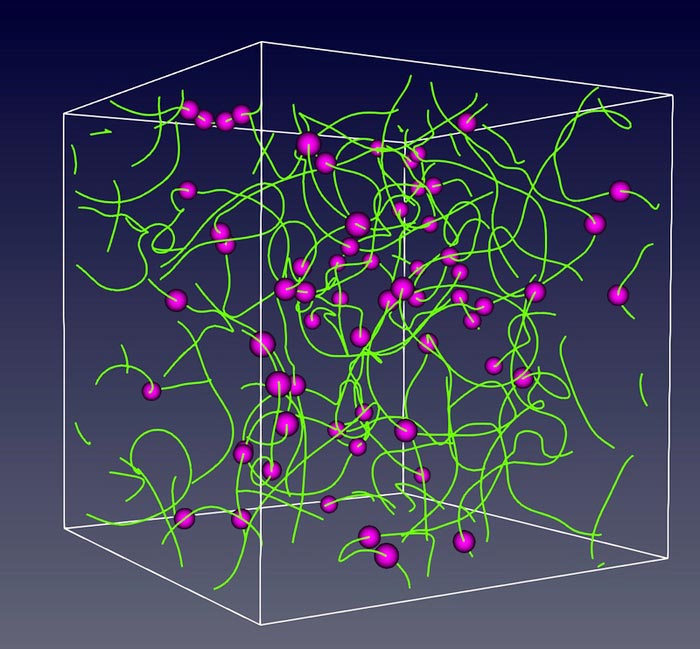

Cores of quantum vortices (green) with tracked particles (purple)
Credit: Makoto Tsubota, Osaka Metropolitan University
A potential step forward in understanding complex quantum turbulence.
A research group of Professor Makoto Tsubota and Specially Appointed Assistant Professor Satoshi Yui, both from the Graduate School of Science and the Nambu Yoichiro Institute of Theoretical and Experimental Physics, Osaka Metropolitan University, in cooperation with their colleagues from Florida State University and Keio University, conducted a systematic numerical study of vortex diffusion in quantum turbulence in superfluid helium-4 (He II) at extremely low temperatures, near absolute zero (−273°C), and compared the results with experimental observations.
The research team used a computer simulation to study quantum turbulence in superfluid helium-4. They inserted particles that followed tangles, which are hairball-like quantum, and analyzed the particles’ trajectory.
The systematic numerical study revealed that vortices first underwent “superdiffusion,” spreading quickly over a short time period, and then transitioned to “normal diffusion” over a longer time period. This transition is thought to be due to the reconnection of vortices when they encounter each other.
The simulation results were consistent with experimental observations, creating a possible further means of understanding complex quantum turbulence.
Furthermore, simulations over a wide range of temperatures, from absolute zero to roughly 2 K (equal to −271°C), showed insignificant changes in the “superdiffusion” index. This indicates a robust law of “superdiffusion” that is not heavily dependent on parameters such as temperature.
“In this study, we investigated the diffusion of particles in a quantum fluid at cryogenic temperatures and found that the transition from ‘superdiffusion’ to ‘normal diffusion’ depends on the time,” concluded Professor Tsubota. “This law may provide a new way to understand complex quantum turbulence.”
About OMU
Osaka Metropolitan University is a new public university established by a merger between Osaka City University and Osaka Prefecture University in April 2022. For more science news, see https://www.upc-osaka.ac.jp/new-univ/en-research/, and follow @OsakaMetUniv_en, or search #OMUScience.
Journal: Physical Review Letters
DOI: 10.1103/PhysRevLett.129.025301
Method of Research: Computational simulation/modeling
Subject of Research: Not applicable
Article Title: Universal anomalous diffusion of quantized vortices in ultraquantum turbulence
Article Publication Date: 5-Jul-2022
Media Contact
Ngoc Han Hoang
Osaka Metropolitan University
koho-ipro@ml.omu.ac.jp














